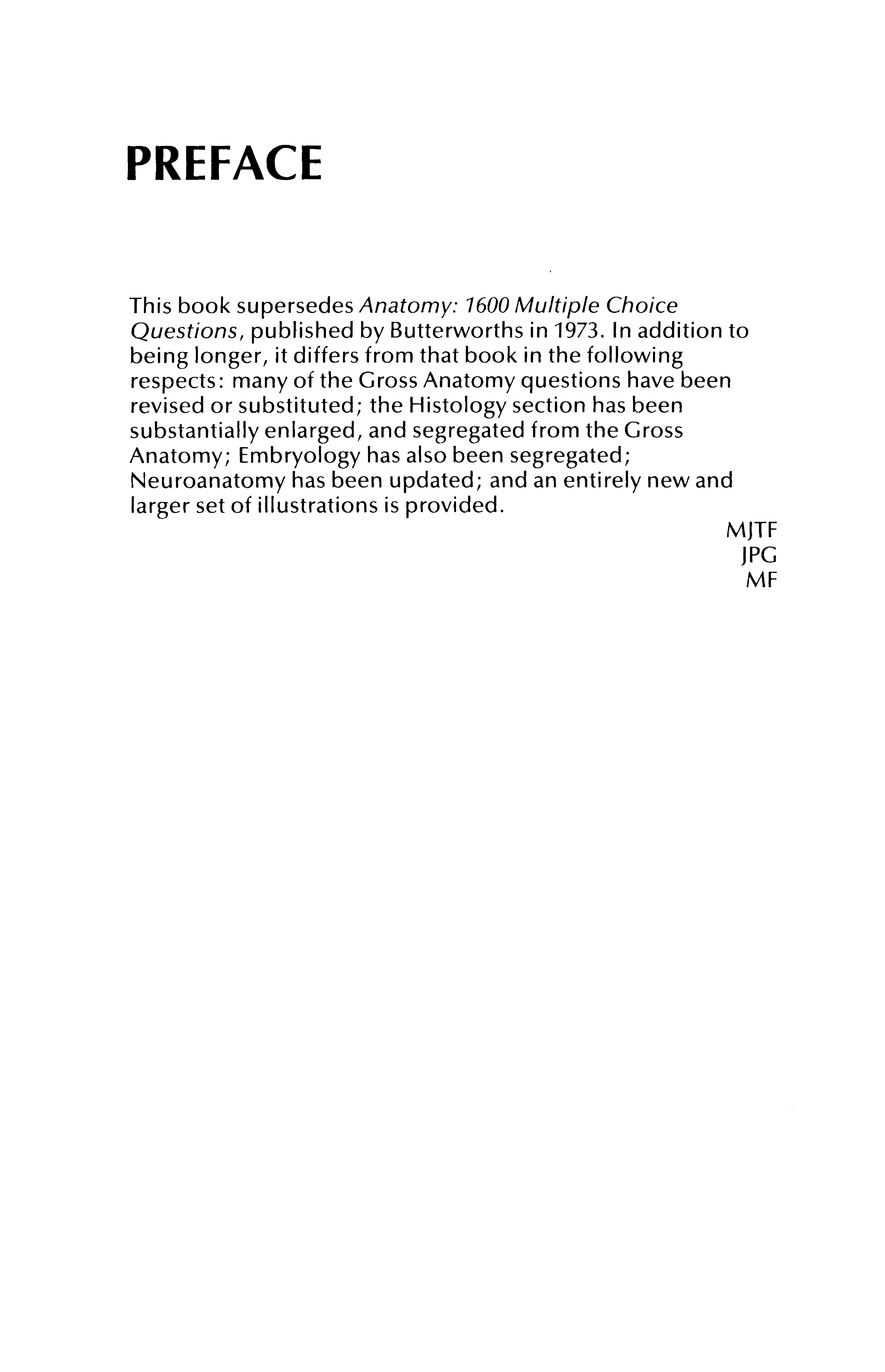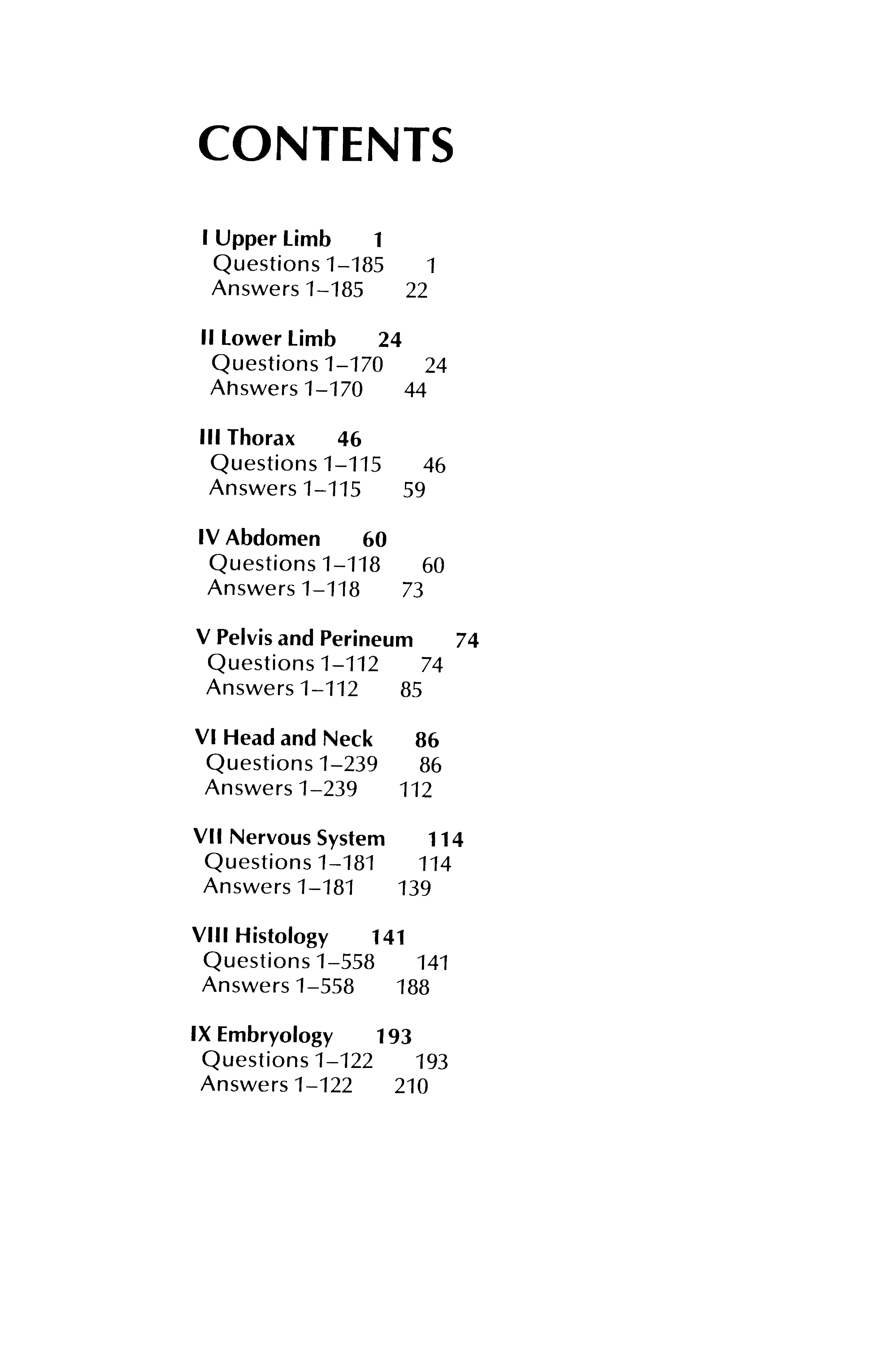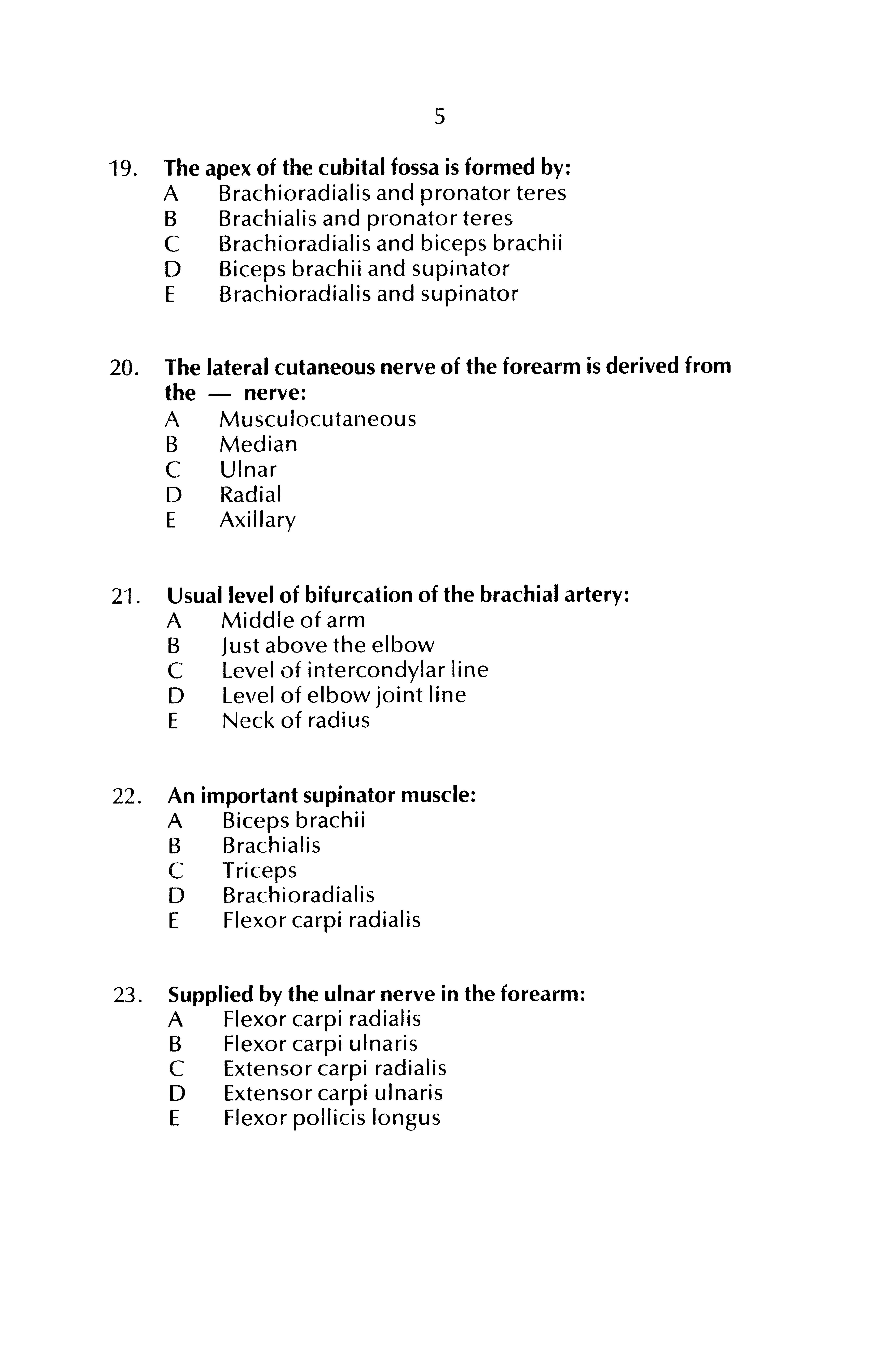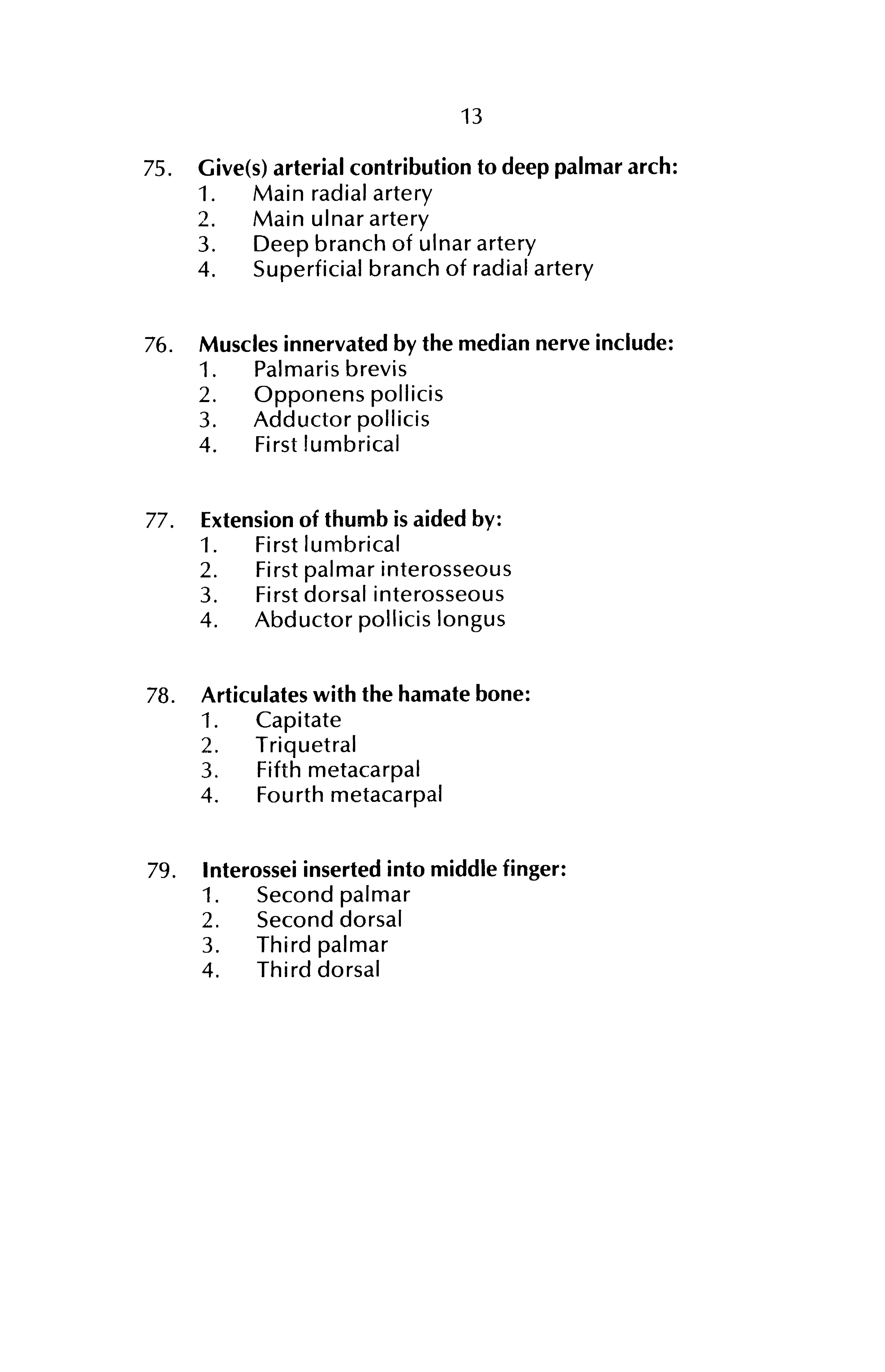I UPPER LIMB
Questions 1-39
For each of the following multiple choice questions select the one most appropriate answer:
1. The spine of the scapula is continued laterally as the:
A Coracoid porcess
B Angle of the scapula
C Infraglenoid tubercle
D Supraglenoid tubercle
E Acromion
2
Muscle attached to the coracoid process of scapula:
A Biceps
B Triceps
C Pectoralis major
D Deltoid
E Serratus anterior
3 Vein which pierces the clavipectoral fascia:
A Basilic
B Lateral pectoral
C Internal thoracic
D Axillary
E Cephalic
The axillary vein:
A Is lateral to the axillary artery
B Is devoid of valves
C Lies anterior to pectoralis minor
D Is directly continuous with the brachiocephalic vein
E None of the above
Branch of the axillary artery:
A Suprascapular
B Transverse cervical
C Lateral thoracic
D Nutrient artery to humerus
E Internal thoracic
Origin from lateral cord of brachial plexus:
A Axillary nerve
B Ulnar nerve
C Lateral cutaneous nerve of forearm
D Musculocutaneous nerve
E Suprascapular nerve
The humerus may be rotated laterally by:
A Subscapulars
B Supraspinatus
C Pectoralis major
D Deltoid
E None of the above
The muscle pair responsible for abducting the humerus to a right angle:
A Deltoid and subscapularis
B Deltoid and supraspinatus
C Supraspinatus and subscapularis
D Teres major and subscapularis
E Deltoid and teres major
19 The apex of the cubital fossa is formed by:
A Brachioradialis and pronator teres
B Brachialis and pronator teres
C Brachioradialis and biceps brachii
D Biceps brachii and supinator
E Brachioradialis and supinator
20 The lateral cutaneous nerve of the forearm is derived from the — nerve:
A Musculocutaneous
B Median
C Ulnar
D Radial
E Axillary
21. Usual level of bifurcation of the brachial artery:
A Middle of arm
B Just above the elbow
C Level of intercondylar line
D Level of elbow joint line
E Neck of radius
22. An important supinator muscle:
A Biceps brachii
B Brachialis
C Triceps
D Brachioradialis
E Flexor carpi radialis
23. Supplied by the ulnar nerve in the forearm:
A Flexor carpi radialis
B Flexor carpi ulnaris
C Extensor carpi radialis
D Extensor carpi ulnaris
E Flexor pollicis longus
35. Number of muscles inserted on index finger:
A Three
B Four
C Five
D Six
E Seven
36 In the hand, the median nerve supplies:
A Abductor pollicis brevis
B Adductor pollicis
C First palmar interosseous
D Abductor pollicis longus
E Extensor indicis
37 The innervation of the lumbrical muscles is related to the innervation of:
A Flexor digitorum superficialis
B Flexor digitorum profundus
C Extensor digitorum
D The interossei
E The two flexor carpi muscles
38. The skin of the index finger is supplied by:
A Ulnar and radial nerves
B Radial and median nerves
C Median and ulnar nerves
D Median only
E Radial only
39 The skin of the palm is supplied by:
A Ulnar and median nerves
B Radial and median nerves
C Radial and ulnar nerves
D Ulnar nerve alone
E Radial nerve alone
The weight of the upper limb is transmitted to the trunk via the:
1. Trapezius muscle
2. Coracoclavicular ligaments
3. Clavicle
4. Deltoid muscle
Division of the long thoracic nerve is manifested by:
1. Inability to retract the scapula
2. Wasting of the pectoralis major muscle
3. Weakness of humeral adduction
4 'Winging' of the scapula
Bursa(e) in communication with the shoulder joint synovial cavity:
1 Subacromial
2 Supraspinatus
3 Infraspinatus
4 Subscapular
Origin from medial epicondyle of humerus:
1 Flexor carpi radialis
2. Palmaris longus
3. Pronator teres
4. Flexor carpi ulnaris
Hinge joint(s):
1 Humero-ulnar
2. Metacarpophalangeal
3. Interphalangeal
4. Wrist
The flexor carpi radialis muscle:
1. Is a flexor of the wrist
2. Is an abductor of the wrist
3. Is supplied by the median nerve
4. Grooves the trapezoid bone
69. Brachioradialis muscle:
1. Arises from lateral supracondylar line
2 Inserts into distal end of radius
3 Is a flexor of elbow joint
4 Is supplied by the median nerve
70. The posterior interosseous nerve:
1. Passes between the radius and ulna
2 Lies on the interosseous membrane throughout its course
3. Is cutaneous to the back of the hand
4. Supplies the extensor digitorum muscle
71 The ulnar nerve usually supplies:
1 The medial half of flexor digitorum superficialis
2 The lumbrical to the little finger
3 The abductor pollicis brevis
4. The first dorsal interosseous muscle
72. Joint(s) containing intra-articular fibrocartilage:
1. Sternoclavicular
2. Temporomandibular
3. Acromioclavicular
4 Fi rst carpometacarpal
73 Muscle(s) supplied by anterior interosseous nerve:
1 Flexor digitorum profundus
2 Flexor pollicis longus
3. Pronator quadratus
4. Pronator teres
74. Bony attachment(s) of the flexor retinaculum:
1. Scaphoid
2. Trapezium
3. Hamate
4 Pisiform
75. Give(s) arterial contribution to deep palmar arch:
1. Main radial artery
2. Main ulnar artery
3 Deep branch of ulnar artery
4 Superficial branch of radial artery
76. Muscles innervated by the median nerve include:
1. Palmaris brevis
2. Opponens pollicis
3 Adductor pollicis
4 First lumbricai
77. Extension of thumb is aided by: 1. First lumbricai
2 First palmar interosseous
3 First dorsal interosseous
4 Abductor pollicis longus
78. Articulates with the hamate bone: 1 Capitate 2 Triquetral
3 Fifth metacarpal
4 Fourth metacarpal
79. Interossei inserted into middle finger:
1. Second palmar
2. Second dorsal
3. Third palmar
4 Third dorsal
Questions 80-104
The group of questions below consists of numbered headings, followed by a list of lettered words or phrases. For each heading select the one word or phrase which is most closely related to it.
Note: Each choice may be used only once.
80. Coracobrachialis
81. Supraspinatus
82. Suscapularis
83. Pectoralis minor
84. Infraspinatus
Flexion of humerus
Lateral rotation of humerus
Abduction of humerus
Medial rotation of humerus
None of the above
85 Common interosseous
artery
86. Profunda brachii artery
87. Suprascapular artery
88. Radialis indicis artery
89. Lateral thoracic artery
90. Trapezius
91. Deltoid 92 Brachialis 93 Supinator 94 Flexor carpi ulnaris
None of the above
nerve
of the above
95. Flexion of the elbow
96. Abduction of the
Musculocutaneous shoulder nerve
97. Extension of the elbow
98. Pronation of the
Radial nerve
Ulnar nerve forearm
99. Abduction of index finger
Axillary nerve
100 Flexion of wrist A Extensor digitorum and extensor digiti minimi
101 Extension of wrist
102. Extension of fingers
103 Adduction of wrist
104 Abduction of wrist
Flexor and extensor
Flexor carpi radialis and radial carpal extensors carpi ulnaris D Radial and ulnar carpal extensors E
Flexor carpi radialis and flexor carpi ulnaris
Questions 105-159
In reply to the following questions indicate whether you think each statement is True or False:
The serratus anterior:
105 Arises by digitations from the lower eight ribs
106 Inserts into the axillary border of scapula
107. Acts synergistically with trapezius in abduction of arm to 90 degrees
108. Nerve supply from thoracodorsal nerve
109. Paralysis gives rise to the condition known as 'winged scapula'
The axillary nerve:
110 Is a branch of the posterior cord of the brachial plexus
111 Is closely related to the shoulder joint
112 Is a purely motor nerve
113 Is accompanied by the profunda brachii artery
114. Pierces coracobrachialis
The axillary artery:
115 Begins at the upper border of the clavicle
116. Terminates as it crosses the inferior border of pectoralis minor
117 Is contained in the axillary sheath
118 Has the median nerve anterior to its proximal third
119 Has the radial nerve behind its distal third


















